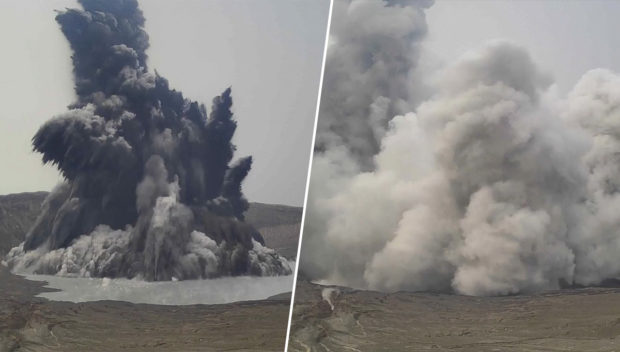NDRRMC wary of rains near Taal; possible lahar flow to be discussed

OMINOUS SIGHT A dark plume of steam, rocks and magma fragments rises about a kilometer high from the main crater of Taal Volcano on Thursday afternoon, sending residents of nearby towns into panic. Phivolcs raised the alert status of Taal to Level 3, indicating magmatic unrest, and recommended the evacuation of residents in two Batangas towns. —VIDEOGRAB FROM PHIVOLCS
MANILA, Philippines — Aside from the Taal Volcano activity, the National Disaster Risk Reduction Management Council (NDRRMC) admitted of monitoring the weather patterns as well, especially after state meteorologists stated that rainfall may be experienced in several areas near the volcano.
NDRRMC executive director Undersecretary Ricardo Jalad explained on Friday that possible low pressure areas (LPAs) may not only bring rainfall in Batangas and Cavite towns surrounding the volcano, but also influence how the volcanic plume and the volcanic smog, also known as vog, spreads.
The council had a meeting prior to Jalad’s briefing, which included various agencies concerned like the Philippine Atmospheric, Geophysical and Astronomical Services Administration (Pagasa), Philippine Institute of Volcanology and Seismology (Phivolcs), and the Department of Health (DOH).
“Di naman magdevelop into a tropical storm or a typhoon, but ‘yong low pressure area na ‘yan magdudulot ng pag-uulan at saka malakas na hangin. At ‘yong hangin na ‘yon ay posibleng magtulak ng ‘yong ash fall do’n sa iba’t ibang lugar depende sa direksyon ng hangin,” he told reporters in an online briefing.
(It is not seen to develop into a tropical storm or a typhoon, but the low pressure area may bring rains and strong winds. And those winds may push ash fall toward different areas, depending on wind direction.)
Earlier, state meteorologists from the Pagasa warned residents near the volcano that isolated rains would occur in the coming hours — which may possibly interact with Taal Volcano’s phreatomagmatic eruption on Thursday.
Pagasa said that people living near the Taal caldera should remain vigilant as to the possible effects of the rain on volcanic material.
READ: Localized thunderstorms may induce rain near Taal Volcano, Pagasa warns
According to Jalad, the spread of the vog, and the possible ash fall if Taal Volcano makes a stronger explosion, would rely on where the LPA would be situated.
“Iba’t iba ang wind direction with respect to Taal, kasi alam naman natin ‘yong hangin na dala ng LPA, umiikot ‘yan counter-clockwise,” Jalad said. “So depende sa location ng LPA, so iba’t ibang location ‘yong pinakita kanina ng Pagasa, kaya nga isa rin ‘yan sa pinag-usapan kanina.”
(There are different wind directions with respect to Taal Volcano, because we know that the low pressure area spins counter-clockwise. So it would depend on the LPA’s location, which Pagasa is actually showing different possible locations. That’s why we also talked about it earlier.)
“Magpapalabas ang Phivolcs ng advisory depende sa makikita nila, ‘yong pagbuga at saka ‘yong direction ng hangin. So titignan natin sa advisory na ire-release ng Phivolcs,” he added.
(Phivolcs will release an advisory depending on what they would see, depending on the plumes and the wind direction. So we would look at the advisory from Phivolcs.)
Despite the possible rains, Jalad said that NDRRMC and other agencies have not yet discussed any possible lahar or mudflow from Taal Volcano.
“Tungkol sa lahar flow, hindi pa natin napag-uusapan ‘yan pero ang Phivolcs naman ay magbibigay ng advisory base sa nakikita nila na rainfall forecast, so hintayin natin ang ilalabas ng Phivolcs tungkol dyan,” Jalad said.
(About the lahar flow, we have not talked about it yet but Phivolcs would give an advisory based on the rainfall forecasts given to them, so let’s just wait for the information that Phivolcs would release.)
“At ‘yong ulan na inaasahan natin ay base sa naalala ko sa presentation ng Phivolcs, mostly light to moderate but merong mga areas na mataas-taas din ano. So titignan naman ng Phivolcs yan, syempre kapag malakas na ang ulan ay talagang ibababa niya ‘yong mga deposits ng ashes na nailuwa ng Taal noon pang unang pagputok niya last year,” he added.
(And based on the presentation by Phivolcs, we are expecting mostly light to moderate rains but there are areas which may experience stronger rain fall. So Phivolcs would look at that, of course if the rain is strong, it would really bring down the deposited materials which Taal spewed — possibly including those from last year’s incident.)
A phreatomagmatic eruption occurred in Taal Volcano on Thursday afternoon, spewing ash and other materials about a kilometer high in the air. Due to the activity, Phivolcs raised Alert Level 3 over the area, which means some hazard-prone barangays in the town of Agoncillo and Laurel in Batangas should be evacuated.
READ: Alert Level 3 raised on Taal Volcano after emitting kilometer-high phreatomagmatic plume
Earlier, Phivolcs shared a drone footage showing continuous upwelling within Taal Volcano’s main crater lake, an indication that magma or other volcanic materials are making waters rise.
Phivolcs said that the drone footage also saw plumes as high as three kilometers as Taal Volcano continues its degassing activities.
WATCH: Upwelling on Taal Volcano’s main crater lake continues
Degassing activities are taken as a good sign by Phivolcs, as Undersecretary Renato Solidum explained on Thursday that they are not expecting Taal Volcano to erupt like it did in January 2020, because degassing means the volcano has been depressurized — and cannot make a strong impact.
READ: Phivolcs not expecting Taal Volcano to erupt like in January 2020














